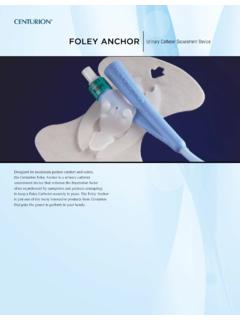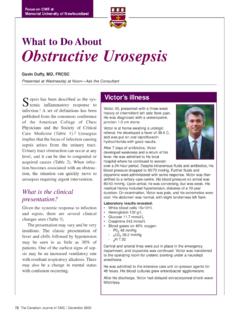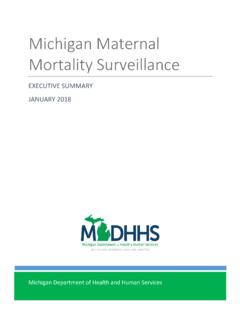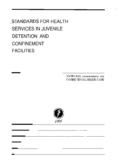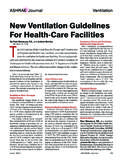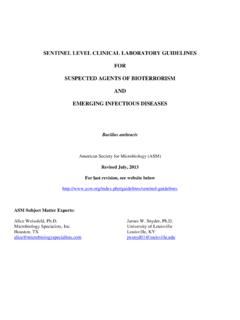Transcription of Surveillance Definitions of Infections in Long-Term Care ...
1 Surveillance Definitions of Infections in Long-Term Care Facilities: Revisiting the McGeerCriteriaAuthor(s): Nimalie D. Stone MD, Muhammad S. Ashraf MD, Jennifer Calder PhD,Christopher J. Crnich MD, Kent Crossley MD, Paul J. Drinka MD, Carolyn V. Gould MD,Manisha Juthani-Mehta MD, Ebbing Lautenbach MD, Mark Loeb MD, Taranisia MacCannellPhD, Preeti N. Malani MD, Lona Mody MD, Joseph M. Mylotte MD, Lindsay E. Nicolle MD,Mary-Claire Roghmann MD, Steven J. Schweon MSN, Andrew E. Simor MD, Philip MD, Kurt B. Stevenson : Infection Control and Hospital Epidemiology, Vol. 33, No. 10 (October 2012), by: Cambridge University Press on behalf of The Society for HealthcareEpidemiology of AmericaStable URL: : 14-03-2017 16:37 UTC JSTOR is a not-for-profit service that helps scholars, researchers, and students discover, use, and build upon a wide range of content in a trusteddigital archive.
2 We use information technology and tools to increase productivity and facilitate new forms of scholarship. For more information aboutJSTOR, please contact Your use of the JSTOR archive indicates your acceptance of the Terms & Conditions of Use, available University Press, The Society for Healthcare Epidemiology of America arecollaborating with JSTOR to digitize, preserve and extend access to Infection Control and HospitalEpidemiologyThis content downloaded from on Tue, 14 Mar 2017 16:37:49 UTCAll use subject to control and hospital epidemiologyoctober 2012, vol. 33, no. 10shea/cdc position paperSurveillance Definitions of Infections in Long-Term Care Facilities:Revisiting the McGeer CriteriaNimalie D.
3 Stone, MD;1 Muhammad S. Ashraf, MD;2 Jennifer Calder, PhD;3 Christopher J. Crnich, MD;4 Kent Crossley, MD;5 Paul J. Drinka, MD;6 Carolyn V. Gould, MD;1 Manisha Juthani-Mehta, MD;7 Ebbing Lautenbach, MD;8 Mark Loeb, MD;9 Taranisia MacCannell, PhD;1 Preeti N. Malani, MD;10,11 Lona Mody, MD;10,11 Joseph M. Mylotte, MD;12 Lindsay E. Nicolle, MD;13 Mary-Claire Roghmann, MD;14 Steven J. Schweon, MSN;15 Andrew E. Simor, MD;16 Philip W. Smith, MD;17 Kurt B. Stevenson, MD;18 Suzanne F. Bradley, MD10,11for the Society for Healthcare Epidemiology Long-Term Care Special Interest Group*(See the commentary by Moro, on pages 978 980.)
4 Infection Surveillance Definitions for Long-Term care facilities (ie, the McGeer Criteria) have not been updated since 1991. An expertconsensus panel modified these Definitions on the basis of a structured review of the literature. Significant changes were made to the criteriadefining urinary tract and respiratory tract Infections . New Definitions were added for norovirus gastroenteritis andClostridum Control Hosp Epidemiol2012;33(10):965-977 Affiliations: 1. Centers for Disease Control and Prevention, Atlanta, Georgia; 2. East Carolina University, Greenville, North Carolina; 3. New YorkMedical College, Valhalla, New York; 4.
5 University of Wisconsin and William S. Middleton VA Medical Center, Madison, Wisconsin; 5. University ofMinnesota and Minneapolis VA Medical Center, Minneapolis, Minnesota; 6. Medical College of Wisconsin, Milwaukee, Wisconsin; 7. Yale University Schoolof Medicine, New Haven, Connecticut; 8. University of Pennsylvania School of Medicine,Philadelphia, Pennsylvania; 9. McMaster University, Hamilton,Ontario, Canada; 10. University of Michigan Medical School, Ann Arbor, Michigan; 11. Geriatric Research Education and Clinical Center, VA Ann ArborHealthcare System, Ann Arbor, Michigan; 12. University at Buffalo School of Medicine and Biomedical Sciences, Buffalo, New York; 13.
6 University ofManitoba, Winnipeg, Manitoba, Canada; 14. University of Maryland School of Medicine and Baltimore VA Medical Center, Baltimore, Maryland; 15. Pleas-ant Valley Manor Nursing Home, Stroudsburg, Pennsylvania; 16. University of Toronto School of Medicine, Toronto, Ontario, Canada; 17. University ofNebraska Medical Center, Omaha, Nebraska; 18. Ohio State University Hospitals, Columbus, Ohio.*Members of the Societyfor Healthcare Epidemiology Long-Term Care Special Interest Group are listed at the end of the May 4, 2012; accepted May 7, 2012; electronically published September 6, 2012. 2012 by The Society for Healthcare Epidemiology of America.
7 All rights reserved. 0899-823X/2012/3310-0001$ DOI: McGeer and colleagues proposed the first set of in-fection Surveillance Definitions specifically for use by Long-Term care facilities (LTCFs), their intent was to provide stan-dardized guidance for infection Surveillance activities andresearch studies in nursing homes andsimilar Definitions were adapted from existing Surveillance def-initions (such as those of the Centers for Disease Controland Prevention [CDC] National Nosocomial Infection Sur-veillance) that are used in acute care hospitals and with mod-ifications determined by consensus discussions among infec-tious diseases physicians, geriatricians, and infection controlnurses with experience in LTCFs,1,2using an unstructuredreview of the limited literature available at the time.
8 Theseconsensus Definitions , also known as the McGeer Criteria,have not been validated or updated despite their ongoing useby infection prevention and control programs and in researchstudies of nursing original Surveillance definitions1were specifically de-veloped for use in LTCFs with older adults who required (1)supervision and care for impaired cognition, (2) assistancewith activities of daily living (ADLs), or (3) skilled nursingcare, such as the use of indwelling devices (eg, urinary cath-eters or enteral feeding tubes). At the time the McGeer Cri-teria were developed, these facilities rarely provided intra-venous therapy or had on-site laboratory or radiology servicesfor the diagnosis of new clinical problems.
9 Now, 20 yearslater, these Definitions should still be applied in skilled nursingfacilities and nursing homes that care for the postacute andfrail elder populations, as well as in other Long-Term resi-dential care environments that deliver medical and skillednursing services if appropriate clinical and diagnostic eval-uations can be provided. However, the McGeer Criteria werenot designed for use in Long-Term acute care hospitals, acuteinpatient rehabilitation facilities, orpediatric March 2009, members of the Society for HealthcareEpidemiology of America (SHEA) Long-Term Care SpecialInterest Group (LTCSIG) agreed that the Surveillance defi-nitions of Infections in LTCFs should be updated in light ofThis content downloaded from on Tue, 14 Mar 2017 16:37:49 UTCAll use subject to control and hospital epidemiologyoctober 2012, vol.
10 33, no. 10(1) a substantial increase in the body of evidence-based lit-erature about Infections in the elderly in LTCF settings, (2)the availability of improved diagnostics for infection sur-veillance, (3) the changing populations of patients who arecared for in nonhospital settings, and (4) the updated acutecare hospital Surveillance Definitions of the CDC s NationalHealthcare Safety Network (NHSN). The process of updatingthe McGeer Criteria included an evidence-based structuredreview of the literature in addition to consensus opinionsfrom industry leaders including infectious diseases physiciansand epidemiologists, infection preventionists, geriatricians,and public health of Clinical SyndromesWe systematically reviewed the Definitions of clinical syn-dromes that commonly occur in LTCF residents, includingrespiratory tract Infections (RTIs), urinary tract Infections (UTIs), skin and soft tissue Infections (SSTIs), and gastro-intestinal (GI) tract Infections .



